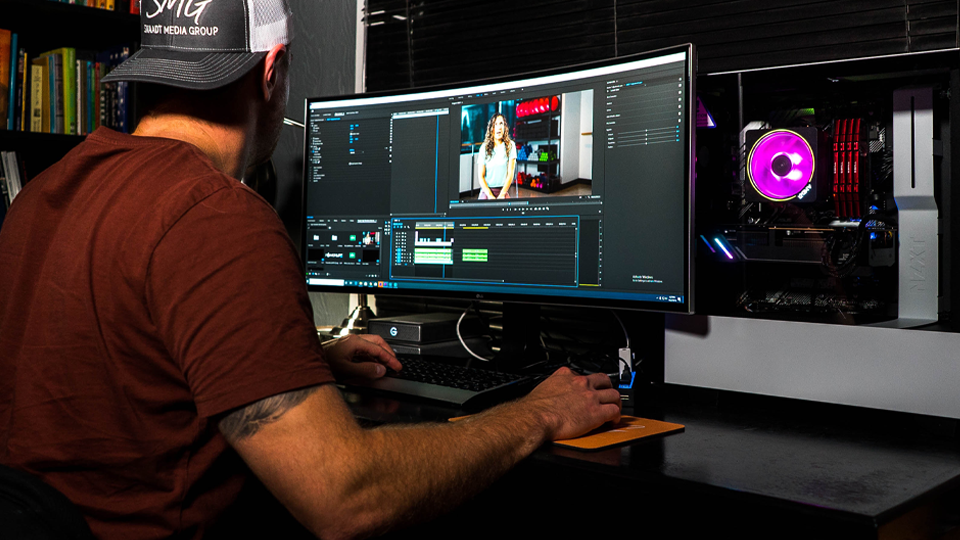The palette matters: The psychology of color and its influence on film & video

Samuel Taggart

10 Minutes

Deliberately manipulating color can greatly affect an audience’s perception of a film, television show or video.
Movies and television shows are primarily visual mediums, and it’s true that everything that appears on-screen has an effect on the viewer’s perception of the story. This, of course, includes the colors we see: the way the lighting illuminates the stage, the color choices of a character’s costume, the overall aesthetic of the set design, red, blue, yellow, orange. We’ll acknowledge that it has been a long, long time since black-and-white movies were the norm, which means filmmakers have had ample opportunity to explore the influence of color on film and television.
In this time, the psychology of color and its influence on video content has been closely examined, revealing vital details about how each color—different blues, pinks, greens, etc—can affect an audience-member’s reaction. Moreover, “color grading” or “color timing,” the art of manipulating color during post production, is more popular than ever thanks to digital editing. With huge advancements in computer technology since the beginnings of cinema, it has become as easy as clicking a few buttons to completely revamp the appearance of a movie, enabling the art form of coloring to emerge as one of the most important to finalizing a modern video project.
In this article, we’re going to dive into the details that surround color and film, and get into the nitty gritty of how to choose the right color palette for your next video project. Everything here applies to content creators, no matter their medium; however, we’re going to lean on examples in film and television to help prove the point.
What is color grading?
Color grading is the process of adjusting the colors and tones of a film project, frame by frame, to establish a desired aesthetic decided upon by the filmmakers. Utilizing a color palette is an artistic choice that helps define the project’s overall look and feel, and color grading is performed during the post production process to ensure the entirety of the film has a unified aesthetic.
What’s the difference between color grading and color correction?
Color correction is the first step in the post production coloring process. The job of the colorist is to make every shot look and feel cohesive by adjusting exposure, white balance, and other basic elements of the footage. Once this step is completed, color grading specialists revisit the project with a more artistic eye, “painting” the film to match the director’s broader vision for tone.
The elements of color – Hue, Saturation & Value
Different colors can evoke different emotions, and filmmakers can use this to their advantage to create a specific atmosphere or feeling. But before we can talk about how to use color, we need to know exactly what it is: When a color is represented on film, a TV screen, or a computer monitor, it can be described using three characteristics: hue, saturation, and value. Each of these characteristics can be adjusted to create millions of distinct colors.
Hue – This is the color itself or, as the dictionary describes it, “the attribute of a color by virtue of which it is discernible as red, green, etc, and which is dependent on its dominant wavelength and independent of intensity or lightness.” In plain English, this means that “hue” describes the spectrum of light from which a specific color originates. For example, red is a different hue than blue or green, but light blue is the same hue as dark blue.
Saturation – This describes the intensity (purity) of the color you’re seeing. Think about a highlighter pink, then about a softer, blush-colored pink; the latter is less intense. Saturation can be a way of acknowledging about “how much” color is present; as more grays/whites are mixed into the color, it reduces the color’s vibrancy (saturation). If you’re a filmmaker looking to have a lush, colorful palette, higher saturation will do the trick; conversely, lower saturation will make a film appear grittier, muted, and moody. It all depends on the look you’re going for…
Value (Brightness) – This refers to a color’s luminance, or how dark or light a color appears to the human eye. On a movie set, this might refer to which characters or objects are well-lit, to creating purposeful shadows—playing with the symbolism of darks and lights—or just simply helping the audience focus their eye on the right spot. Although just a small detail in the grander scope of movie-making, a color’s value can have significant impact on the viewer; whether the colors are bright and flourishing, or shadowy and mysterious, plays into the greater narrative.
How color affects filmmaking decisions and the viewer’s experience
Every color and, therefore, every variation of every color, can be derived from the three primary colors—red, green, blue. The artistry of color correction and color grading rests in finding the balance of these basic elements, and how they interact with the viewer’s experience of the film. Colors can set the tone for a entire production and help create a specific atmosphere or mood. A scene with a blueish atmosphere might create a sense of sadness or melancholy at first glance, while a film with a warmer, yellow- or orange-tinged color grading will likely instill a lighter feeling.
Color correction is often used objectively to unify the visual elements of a production. By adjusting the colors and tones of different shots, a colorist can create a cohesive look that ties the production together. Say you’re a director, and you’re shooting a fast-paced car chase scene—the shoot is complicated and it will take upwards of two weeks to get every angle captured. Over the course of filming, the team will experience different lighting conditions, different weather, etc. The crux? The final product needs to all look the same, as if it were shot in one cohesive moment. That’s where one aspect of the coloring process can shine.
Taking a more stylistic approach to coloring is where the fun (and magic) of the creative endeavor really starts to come to life. Take, for instance, the movie, O Brother, Where Art Thou, filmed in rural Mississippi in the middle of the summer, where it’s lush, green, and vibrant with summer heat. But the directors’ vision of the film required a bleaker, browner, more dried-out visual, echoing the themes of hardship and difficulty faced by the characters. The movie’s creative team added a yellowish-sepia tone to the footage, which completely transformed the appearance of the final cut. It marked the first time anyone had implemented full-blown, digital color correction on a feature-length film, and it worked: The color treatment helps the audience feel the heat in the air, the sweat on the character’s backs.
Color can also evolve over the course of a movie or television series, acting as a character all it’s own within the greater narrative arch of those stories. Go back and watch the first season of “Dexter,” then hit play on the 2022 remake of the same show—the older episodes have a completely different look and feel, simply based on how the color and lighting are edited. Now consider the Harry Potter movies: Over the course of the eight films in the epic tale, the coloring, set design, and visual atmosphere of the films gets progressively darker, mimicking the arch of Harry’s ever-complicating story that began when he was just a young, innocent wizard. Exemplified here, color can manifest as an entire character within a script, playing a quiet, yet undeniable, role in the viewer’s experience of the film.
Examples of color palettes for filmmaking
How exactly can a filmmaker implement color into a film is a nuanced art form. Here, we’ll outline some basic filmmaking color palettes, their emotional and associative relation to the viewer, and how implementing these color schemes plays a significant role in the way the film is experienced.
Monochrome: In a monochrome color palette, a single color dominates the scene, with various shades, tones, and tints of the same color creating the necessary contrast. Black-and-white films are a classic example of this style, despite the fact that it came from necessity. Directors nowadays may choose a monochrome palette to emphasize to direct the audience’s attention toward the composition, lighting, and the emotional nuances of the scene.
Analogous: This color palette uses colors that are directly next to each other on the color wheel. This creates a harmonious effect, often one that appears in nature. A filmmaker’s palette of light blues and purples might create a mysterious or cool atmosphere akin to dusk; yellows and oranges might suggest warmth and comfort from the suns rays. The shift from one analogous color scheme to another can indicate a change in time, place, or emotional states.
Complementary: This palette uses colors that are opposite each other on the color wheel, creating a stark contrast that can add visual interest and pizzazz into a scene. These high-contrast colors can evoke strong emotions, build tension, or highlight conflict within a scene: A director might use a complementary palette to highlight the stark differences between two characters, settings, or worlds, or use it draw the viewer's attention to specific elements in a scene by coloring a key object or character in a way that stands out against the background.
Triadic: A triadic color scheme uses three colors equally spaced around the color wheel, creating a vibrant yet balanced look that allows for variety within the frame, compared to other palettes. Despite its eye-catching effect, a triadic palette can still achieve a sense of harmony—but utilizing these colors takes a keen touch to execute idealistically.
Muted or Desaturated: These color palettes involve reducing the intensity or saturation of colors, often to create a subdued, moody, or realistic atmosphere. Films set in the past often use desaturated colors to mimic the look of old photographs and create a sense of nostalgia. Like you’ve seen in war movies like Saving Private Ryan, directors often used a desaturated color palette to portray the gritty and harsh reality of war. On the other hand, if a film has a primarily desaturated palette, any instance of bright or saturated color will stand out dramatically; this can be a powerful storytelling tool, drawing the viewer's attention to a specific character, object, or moment in the film by contrasting its saturation from the film’s regular style. Some filmmakers may also choose muted colors to present a more realistic, grounded style.
Saturated or Vibrant: These color palettes use highly saturated, bright, and bold colors. They can create a sense of excitement, fantasy, or hyperreality, and are often used in animated films, musicals, fantasy and science-fiction. Warm colors like reds, oranges, and yellows can stir up feelings of passion, energy, or joy, while cool colors like blues and greens can create a sense of calm or melancholy, to put it simply. Overall, saturated, vibrant colors can create strong visual effect, immediately catching the viewer’s attention. These highlight colors can be used to differentiate characters, represent conflict visually, or even indicate changes in the story’s mood.
Color in film is a crucial tool for storytelling. It directly influences viewers' emotions and their interpretation of the narrative playing out on the screen. From the basics of hue, saturation, and value, to artistic impact of color grading and the utilization of specific color palettes, its vital for post production creatives to explore the influence of color on film and video.



































